In this week’s episode, we get a behind-the-scenes look at what it takes to film a wildlife conservation documentary.
Part 1: Documentary producer Mariah Wilson is days into making her film about the endangered Forest Elephant and still hasn’t seen one.
Part 2: Science Journalist Katherine J. Wu interviews Mariah Wilson to learn more about the stars of her documentary Silent Forests.
Mariah Wilson is a documentary producer and director with a focus on wildlife conservation whose work has taken her to six continents. She has worked on series for PBS, Amazon, Netflix, National Geographic, Vice, A&E, Al Jazeera, History, Mongabay, Discovery, Animal Planet, and more.
Her 2019 feature documentary SILENT FORESTS is about the fight to save forest elephants from ivory trafficking in Africa’s Congo Basin. It screened at Santa Barbara, Big Sky (Finalist – Feature Competition), Brooklyn Film Festival (Spirit Award), Jackson Wild WWD (Winner – Stories of Hope) and is a One World Media Award Winner. Mariah’s other producing credits include MADINA’S DREAM (SXSW, Telluride Mountainfilm), MARY JANES (Woodstock, Mill Valley), END OF THE LINE (DOC NYC), and most recently the Amazon Studios film WILDCAT (Sundance Doc Fund, Telluride, AFI, IDFA, National Board of Review Top 5 Documentaries of 2022) Mariah is passionate about illuminating the myriad intersections between humans and animals, and celebrating those dedicated to protecting wildlife. She is a proud Jackson Wild Summit Fellow (2021) and Explorer’s Club Fellow. More at: www.mariahewilson.com
Episode Transcript
Part 1
So, there I was deep in the jungles of the Congo Basin, searching for an animal that was proving to be very elusive, an elephant. I was there making a documentary about forest elephant conservation.
Now, forest elephants are one of the two elephant species that you find in Africa. The one you guys probably know about is the savanna elephant. They're kind of the iconic one that's out in the open grasslands and plains of Africa. But forest elephants, they're the underdog and so I really kind of took a liking to them.
They're what's known as a keystone species, which means that they're really integral to the ecosystem that they exist in. They're actually known as the gardeners of the forest because they'll eat plants and seeds and then walk a bunch of miles and then poop them out, thereby dispersing the seeds all around the forest ecosystem and helping to build more forest. Think of it as like forest architecture via defecation. It's a kind of weird skill set.
So, I was embarking on this adventure with my cinematographer Zeb. He and I had heard of one other project that was concentrating on filming forest elephants and they, unfortunately, had kind of gotten the jump on us. They were filming at the one clearing where you can definitely see these guys. It's like the Grand Central for forest elephants.
Since they were already there, we figured, “You know what? Probably better to not step on their toes. Let's find somewhere else to film.”
I remember thinking to myself, “How hard can it be? I mean, they're freaking elephants. They're huge.” Famous last words.
Our first location we filmed in was in Cameroon where we were filming with this amazing ecoguard named Sidoni. She was one of the first female ecoguards in Cameroon and her job is to patrol the forest looking for poachers and protecting the animals that are there.
And so we get there and, immediately, realize this is a really hard environment to work in. We're marching out behind her and her colleagues 12 miles and they're macheteing their way through the bush just like carving a path that doesn't really exist. It's hot and humid and there's bugs everywhere.
We get to the clearings. We drop off our gear and we set up our cameras. We're like, “Thank God we made it. Here we go,” and the waiting game begins.
Mariah Wilson shares her story at QED in Astoria, Queens in November 2022. Photo by Zhen Qin.
We're waiting and waiting and we don't see a single forest elephant for days. We see signs of them everywhere. We see their tracks. We see their scat. We even hear them one night. It's like they're kind of just toying with our emotions a little. But, no. In the clearings, no forest elephants are coming out.
So, we talked to the ecoguards and they're like, “Yeah, you know, the poaching pressure has been really high here for a while so their population has plummeted and the ones that are still there are scared to come out.”
I thought about this and it made me really sad because this means this home that they've created, that they've helped build, they're scared about coming out into their own home because of what us humans are doing.
I was like, “You know what? Let's give it a few more days. I really want to try to film these guys.”
But the problem was, at this point, Zeb and I had kind of run out of water that we had brought out, potable water. And so we were resorting to filling our water jugs with muddy river water and throwing iodine tablets in and kind of like crossing our fingers, hoping for the best.
Inevitably, we both got a bit of the grumble tummy, as I like to call it. I was sneaking off to do a lot of let's call them shame poops where I would leave as far away as I could go from camp, out of earshot, out of eyeshot, and do my business.
One night, we're sitting around the campfire after dinner and I got the call to go do my thing. So I went like 40 or 50 feet away from the camp and, all of a sudden, I heard the camp get really quiet. Then I heard the ecoguards all whispering to each other.
Then I heard guns cocking and then I heard them say, “Ce qui, ce qui?” “Who is it?”
And, for a second, I got so excited because I was like, “Oh, my God, they caught a poacher. Fuck, yes! Awesome. We're gonna get a great scene. I hope Zeb's rolling on this.”
Then it occurred to me that I was the poacher that they heard, because I was making all this noise out there. I was like, “No, no, no. Ce moi, ce moi. Don't shoot, don't shoot.” And then I slunk back to camp really embarrassed. They're like, “Next time, just tell us what you're doing.”
So, we hadn't seen any elephants but we were seeing a lot of other species. The one that was the most pervasive was a fly. Just regular flies. They were everywhere. You don't think about flies when you're in the forest but they just absolutely swarm your camp.
And the tent that Zeb and I were sharing was especially attractive to them. I think that was the reason they gave us that tent, honestly, because those flies were just on it.
Then we looked closer and we're like they're on top of each other in threes and fours and twos and they're coupling up and they— oh, my God. These flies are fucking. They're having like an orgy on our tent. Our tent was a fly fuck pad and we had not consented to any of this at all.
So, then we look closer and we see this white stuff that they're leaving behind. I'm like, “Is this some kind of weird fly jizz? What is happening here?”
Then, upon closer examination, no. It was just a bunch of baby maggots. Everywhere. On our gear, on our tent.
So we took all our stuff down to the river, wash it off, but there was one bag in particular that was very meshy and they had really just burrowed in there and we just couldn't get them out. So we smoked them out over the fire, neglecting to realize it was the same fire we were smoking fish on for dinner. So that bag ended up smelling like smoked fish forever. Like when we were walking through the forest, it was like a gigantic, vengeful herring was just stalking us.
Mariah Wilson shares her story at QED in Astoria, Queens in November 2022. Photo by Zhen Qin.
But, honestly, it wasn't all bad. There were magical moments too while we were waiting to film these guys. Like sitting around the campfire with the ecoguards and learning about them and learning about their passion for protecting animals like the forest elephant was amazing and inspiring.
For me, my favorite moment of every day was when I walked down to the river to bathe at the end of a long, hot humid day. I would do it right when the sun was going down and the forest was kind of lighting up and these fireflies were all around me. It was magical and ethereal. One night, a firefly even tried to mate with my headlamp, which was so cute and so much better than the sex flies on my tent, a hundred percent.
But, unfortunately, at this point, we still hadn't filmed a single damn elephant, so we decided to make a move. We went to a neighboring country, Congo‑Brazzaville.
We met up with a biologist named Clement and he actually studies the forest elephant's language and communications. He records them and then analyzes their vocalizations to figure out what they're saying to each other.
And he has these observation decks that he's built that are about 30 feet high. On top, there's a 10 by 10 space where four of us adult‑sized humans kind of squeezed in Tetris style with our sleeping bags. It was a bit of a tight, awkward squeeze but we made it happen.
We set up our camera gear and we had an infrared camera with us this time. We, again, played the waiting game for days and days. At this point, I'm just like, “I don't know what I'm doing here. This project that I'm doing and the story I want to tell, I don't know if it can happen if we don't get original footage of forest elephants.” So, I'm pretty stressed out.
That night, I remember saying, “I will do anything to see a forest elephant.”
Well, the next day, I kind of got my wish but in a sad way, because we did find a forest elephant but it was dead. It was a young male and his body was rotting into the forest floor. You could see on his face the machete marks where his tusks had been chopped off by poachers.
Seeing this carcass and seeing it return to where it came from and this young elephant's life cut short, it made me realize I really do need to tell this story. I need to raise awareness about this underdog species that I love.
So with that renewed vigor, I climbed up to the observation tower that night and we went to sleep. In the middle of the night, we woke up to the sound of splashing. We couldn't see what was happening because it was pitch black, but Zeb very quietly got up and turned on the cameras and turned on the infrared light.
Mariah Wilson shares her story at QED in Astoria, Queens in November 2022. Photo by Zhen Qin.
I still couldn't see anything because of infrared, but he could see. I just felt him lean over and tap me on the forearm really excited, just tap, tap, tap, tap, tap. I was like, “We got him.”
Then once I looked through the camera, it was amazing. It was a whole family. It was the matriarch. It was her kids. It was their kids. It was elephant behavior. They're bathing. They're drinking and dunking and interacting with each other. And we even got a tiny baby elephant breastfeeding, suckling on its mom.
I was honestly really relieved that it was dark out because I just started crying. I was so grateful to be in the space with these beautiful animals and so relieved that we had finally been able to get footage of them.
So, we made the film. In hindsight, it's not a big surprise that we had so much trouble filming them. Forest elephants are in really big trouble. They are listed as critically endangered and they've lost about 60% of their population in just ten years, which you don't have to be a math genius to figure that out. The trajectory is not good.
So doing this film made me realize that not only do I want to spend the rest of my career focusing on underreported species but I want to focus on the people, like Clement and Sidoni, who are doing everything they can to protect them because, frankly, all endangered species need all the help we can give them now.
Thank you.
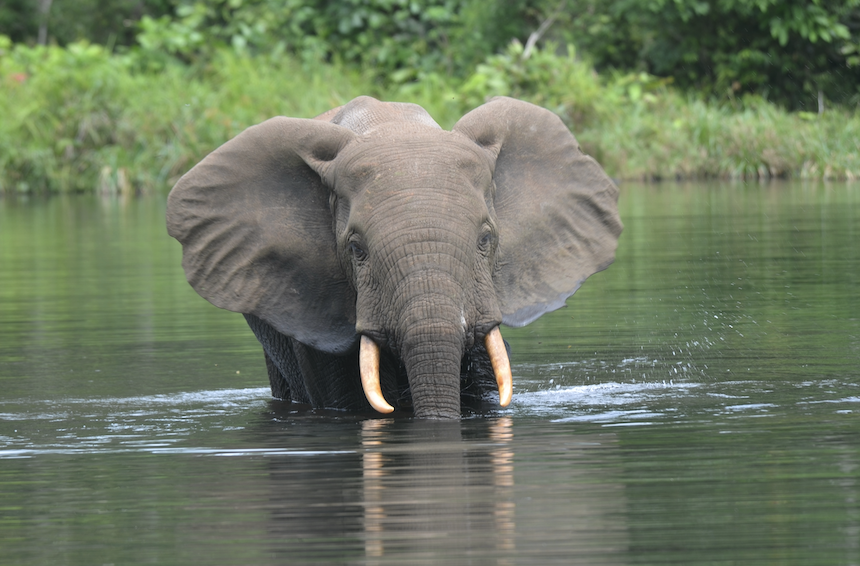

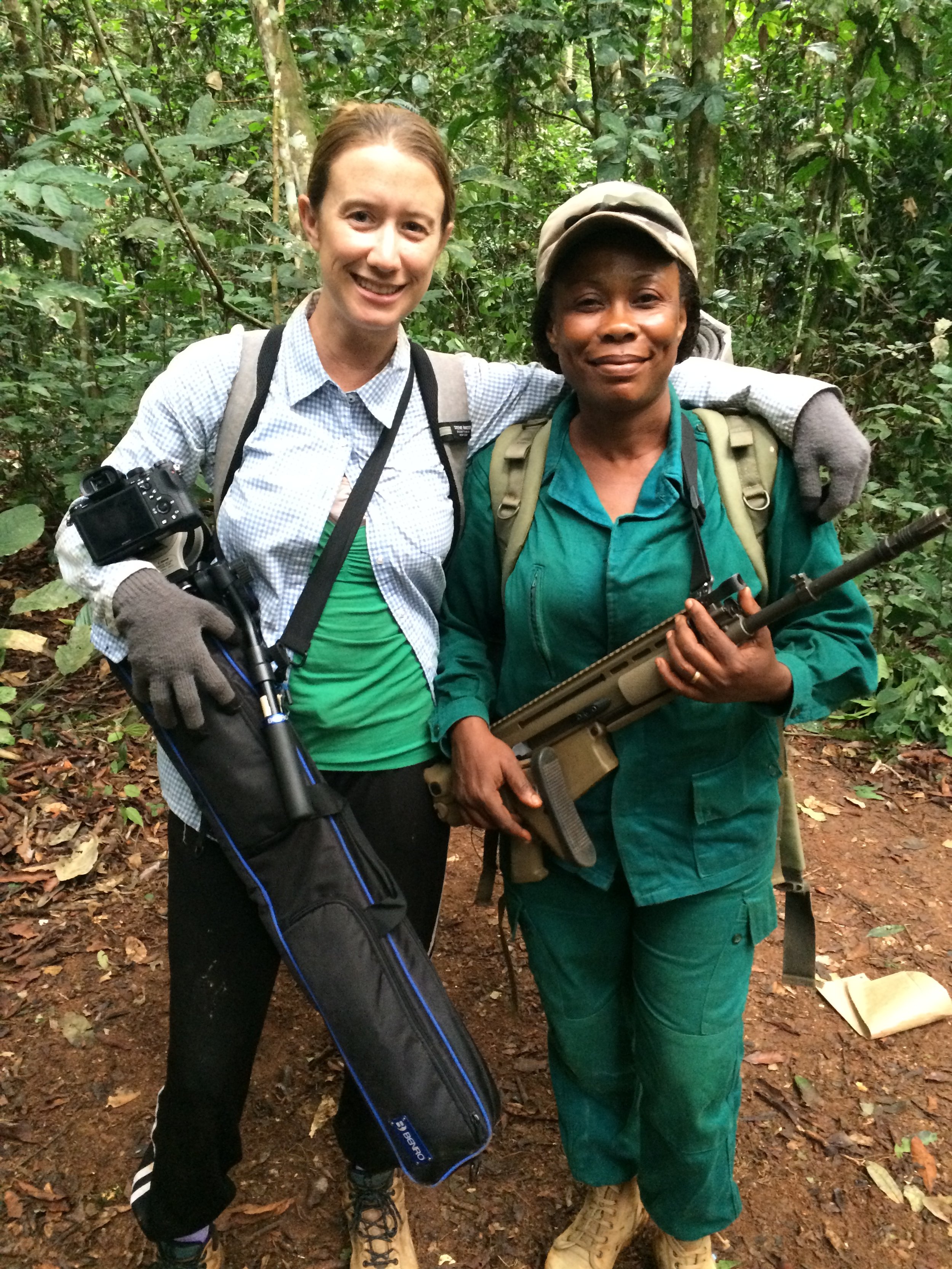
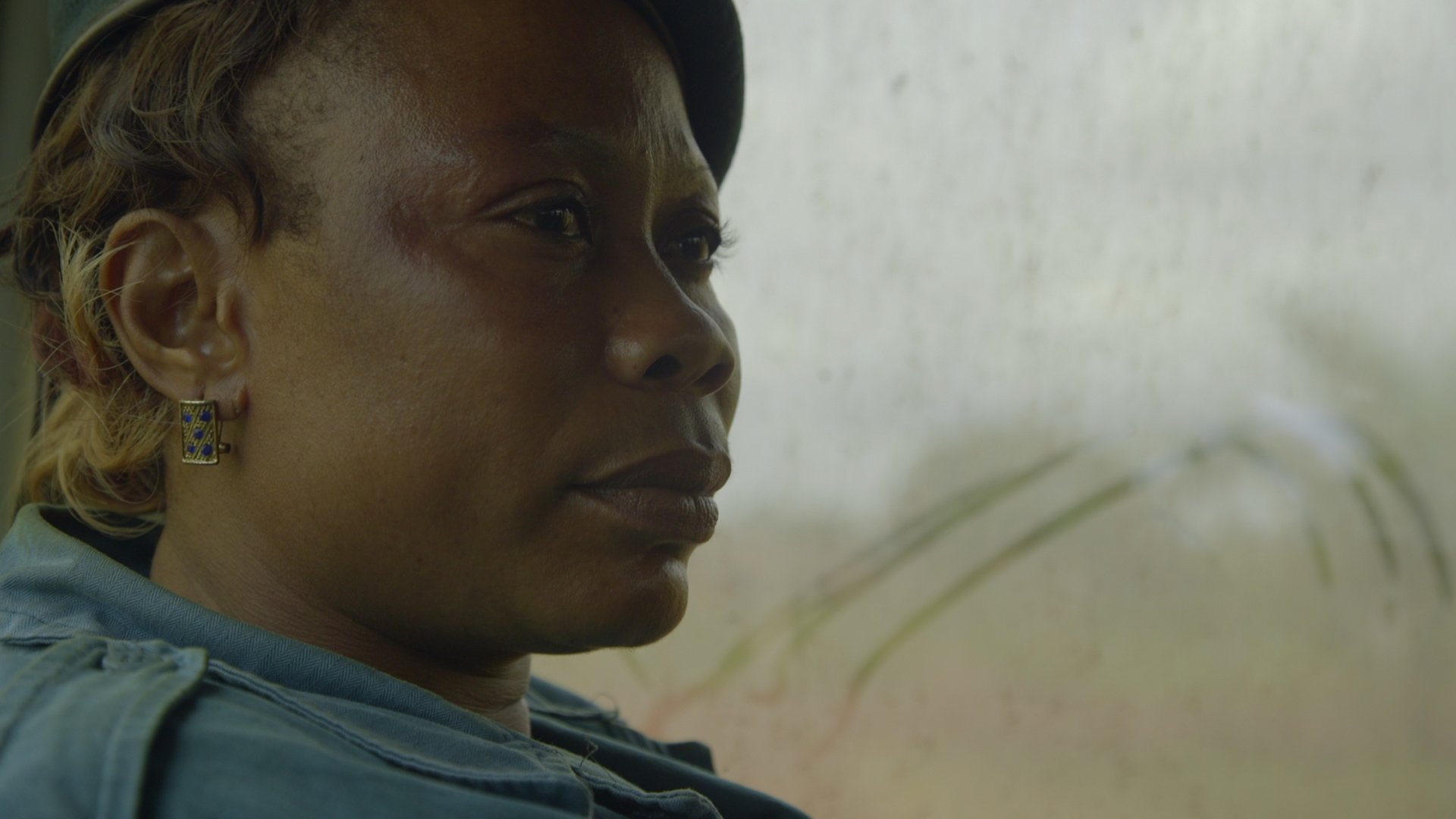

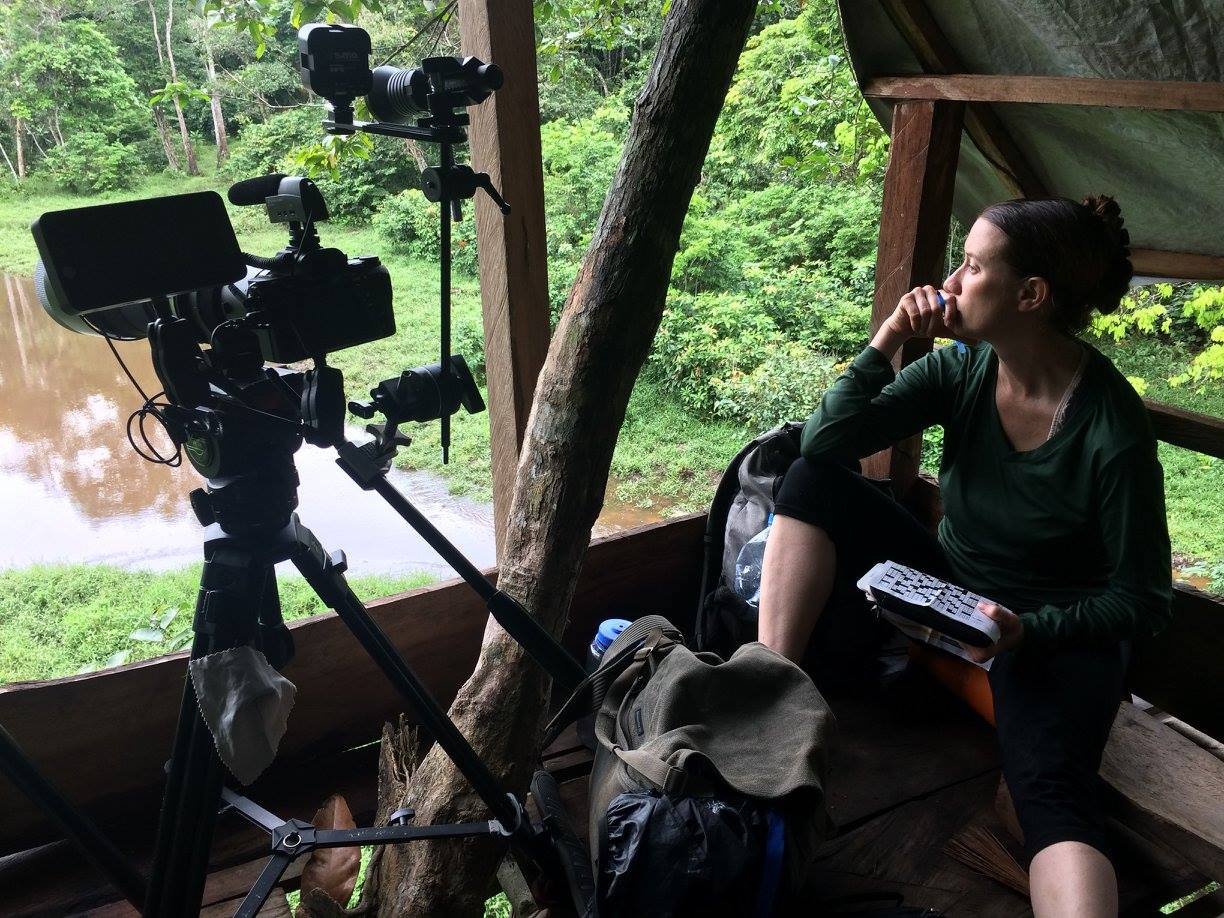
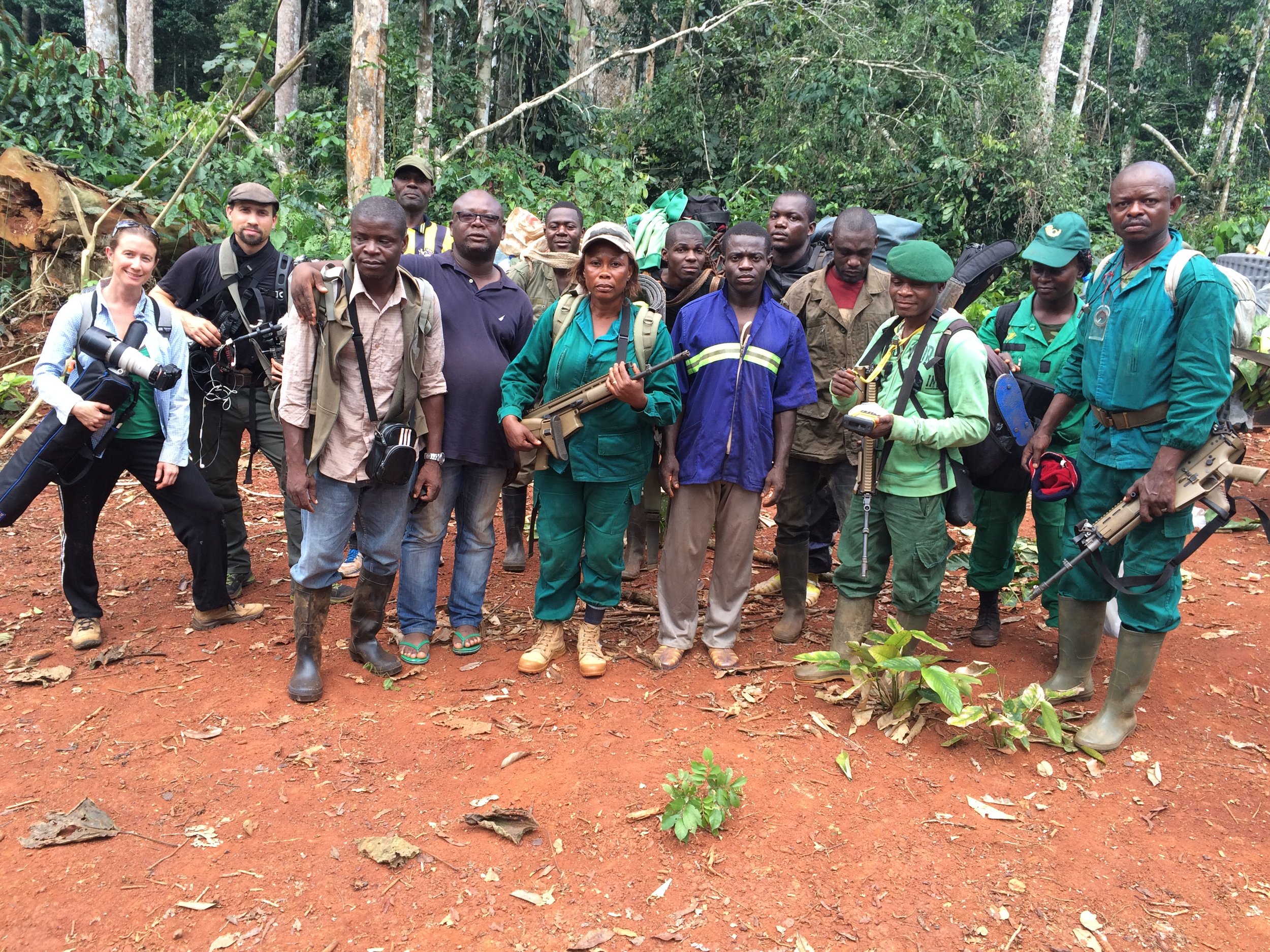
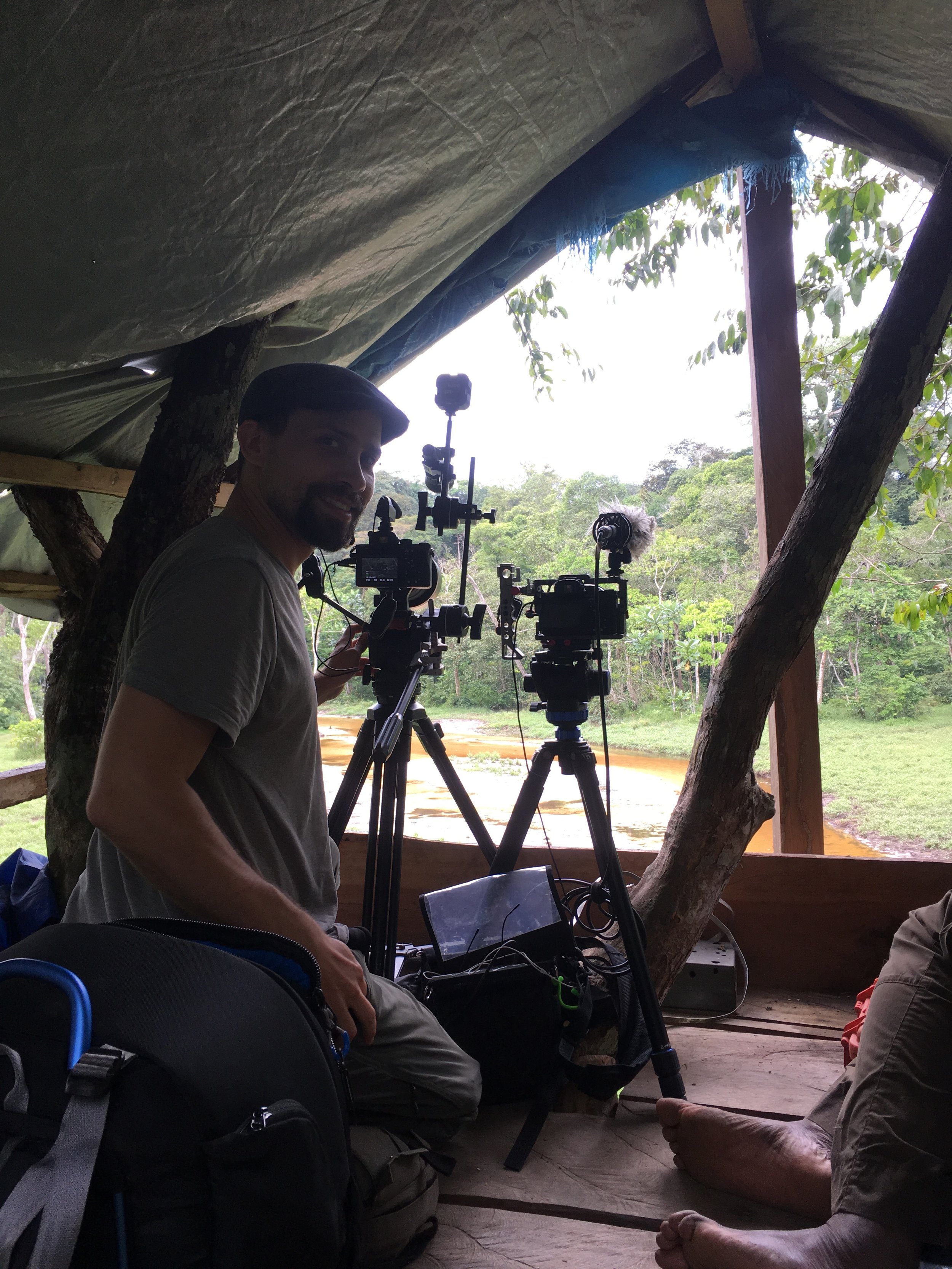
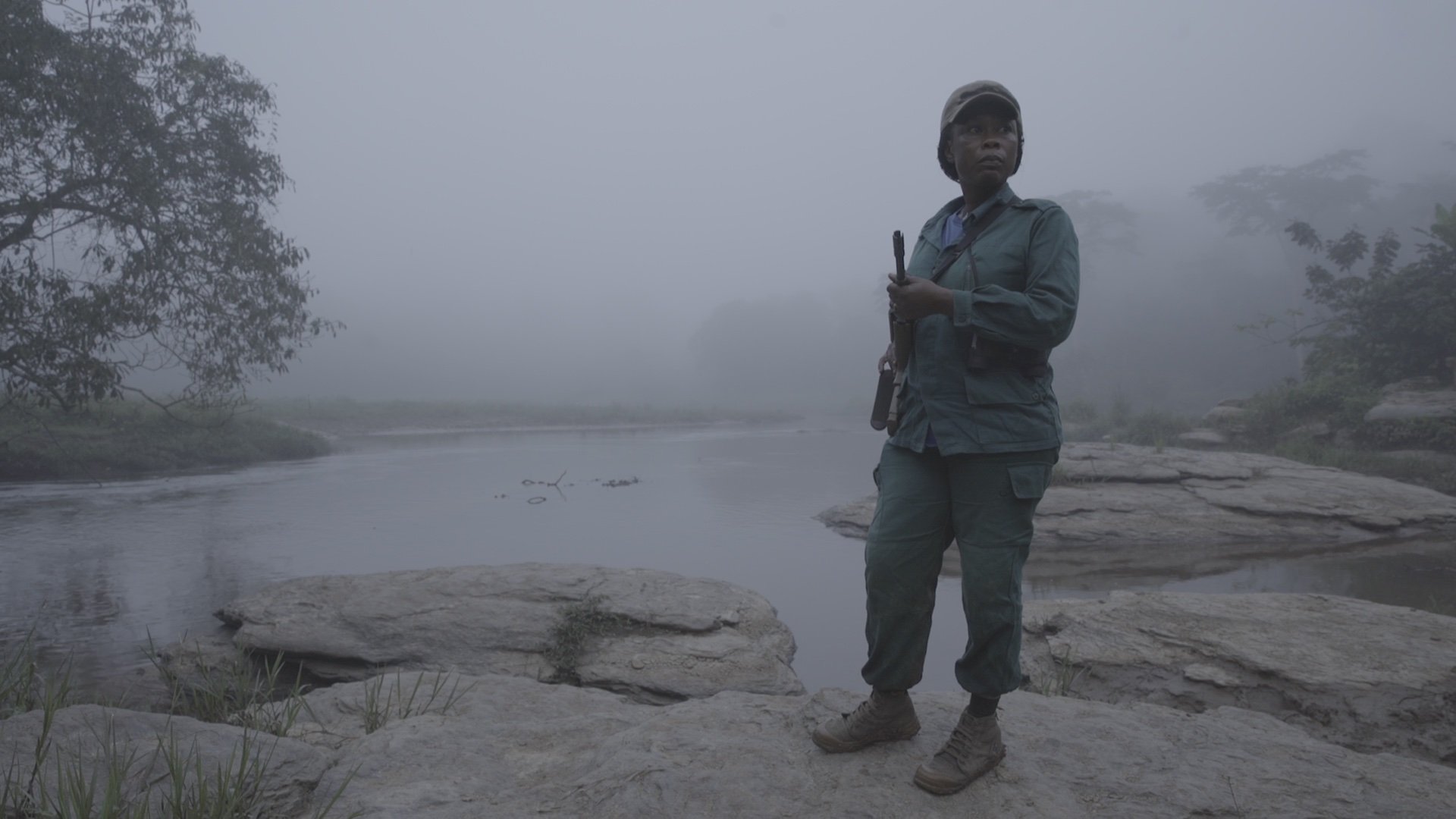
Part 2
Katherine: Now, we're back with Mariah to catch up a little bit about more of the science in her story.
Mariah, thank you so much for joining us. To start us off, tell us a little bit more about forest elephants. How are they different from savanna elephants?
Mariah: Forest elephants are really fantastic and they are different from savanna elephants in that if you think about savanna elephants, they're in these wide open planes and they have a lot of area to graze, so their tusks are actually pointed a bit more up and outward. But forest elephants have to be in these small, very dense ecosystems with tons of trees and thick vegetation, so their tusks point straight down so they don't get their tusks tangled up in different branches and brambles and everything else.
They're a bit smaller as well. They're still big but they weigh less than savanna elephants do. That allows them to kind of navigate through that forest ecosystem better.
Katherine: So they are the savanna elephants packaged into a smaller space, basically.
Mariah: Exactly. Exactly. And they help to actually build that ecosystem out. They're great at eating leaves and seeds. Then they walk and defecate and they disperse the seeds all around the forest to help to plant new trees. There's actually some recent studies that show that the way that they eat and what they eat helps to promote carbon‑dense wood stalks. So they actually help to retain carbon in the forest and so, thereby, they help us out a little bit with climate change.
Katherine: Amazing. One thing I thought I'd bring up that I'm pretty sure, correct me if I'm wrong, forest and savanna elephants have in common, they both live in these amazing matriarchal societies where the ladies are in charge. What is up with that and how unusual is that?
Mariah: That's right. It's wonderful. They have really strong matriarchal societies. The matriarch retains all this knowledge about the ecosystem that she passes down to her children and her children's children, like where's the best watering hole, where’s the yummiest tree to eat. That's why poaching problems are so heartbreaking because sometimes the bigger elephants, like the matriarchs, are taken out and then you have that loss of that institutional knowledge.
So, the way their societies are structured is the matriarchs will stay together. So the daughters will stay with the family and they'll have babies. But if the babies are boys, eventually, when they reach puberty, when they start to go into musth, it's called, they will kind of go off on their own and leave the herd. But the females will stay and they make a family.
Interestingly, the males, when they go into what's called musth, they actually have a hormone that leaks down from their temporal lobe. So you can tell when a male is in heat. It looks like he's crying out of the side of his head. It's really wild. And they are very aggressive during this time.
So if you see an elephant with some wetness on the side of its head, as long as it's not from the rain, then the advice would be to clear away and give it some space to do its thing.
Katherine: You told me just in time. I mean, one thing that you have already alluded to and is such a big, central part of your story is that, obviously, forest elephant populations have really been plummeting in recent years. Tell us a little bit about that and what's going on with poaching in that region.
Mariah: Yeah. It's what kind of got me interested in this project and embarking on this story in the first place was that I read a study. The study was already many years ago now. But that, by best estimates, and it is tricky to figure out the population just given how hard it is to see the forest elephants. They do this based on scat and other kinds of data. But the best estimates show that in about 10 years, over 60% of the forest elephant population was lost in Central Africa, which is an absolutely staggering number.
So, estimates nowadays have their population around 40,000, whereas 20 years ago, it was 200,000. That precipitous drop is really scary. It's what made me decide and be motivated to tell their story because I felt like everybody's doing films about poaching and the ivory trade with savanna elephants but these forest elephants are really getting hit hard.
The bittersweet thing is that because of the forest they live in, as their numbers get lower from poaching, they're going to be harder to find to poach. So there might be like a little bit of stabilization happening now. But I can't say I know exactly what the current number is and no one can because there isn't enough data on how many still exist. But the situation is not particularly good.
Katherine: Are they targeted more often than savanna elephants?
Mariah: Yeah, in a way. I think if you were to look at the numbers of elephants poached, it may be that more savanna elephants have been killed for their ivory just because there were more of them to start with at the beginning of this let's say the modern poaching trend, which kind of started its uptick in the late odds and the early teens.
But the forest elephants are in a lot of countries that have poor resources for conservation and less regulation as a result, so they're an easier target in some ways. I think a lot of the countries in the continent that have savanna elephants have a little more conservation and protection infrastructure for the elephants.
The other twist is that the forest elephant ivory is prized a little bit more on the market for people who buy such things because it's denser, because they have to use it to knock trees down and such and so it has a different quality to it that's prized more on the market, sadly.
Katherine: Wow. Okay. But you had the good fortune of working with Eco‑guards who are doing this really important work of protecting these species. Tell us a little bit more about their job and what it was like to partner up with these amazing people.
Mariah: That was wonderful. So, I filmed with one of the first female Eco‑guards in Cameroon. Her name was Sidonie. She was just such an inspiration because she's a mom. She has several kids that she has to spend long times away from. And she goes out in these very dense, difficult environments to navigate.
I think of myself as a fairly outdoorsy person, but I struggled to keep up with her in the jungle. You just have thorns and vines just grabbing onto you. You feel like the forest is trying to take a piece of you and leave it behind. We had cuts and bruises and scrapes and it's humid and hot. This is her office. This is just where she works every single day.
I was just so amazed by her and all the other Eco‑guards and how much hard work they do for very, very little. And their main job is to patrol the forest looking for poachers, but also to observe the animals. So, they can take notes on how many elephants they're seeing and where they're seeing them and just kind of they are the frontlines for observational data of what animals are out there and still exist in these clearings that have been targeted.
It was amazing to spend time with them and I appreciate all the hard work they do. I do not think I could do it myself, but it was nice to have a peek into that world for a period of time.
Katherine: Yeah. And you were able to capture some of that work on film and, of course, some of these amazing elephants on film. What role do you see your documentaries playing in conservation and the bigger impact they're having for people who can't be there in person?
Mariah: Good question. Every wildlife conservation filmmaker, I think we want to reach an audience that's beyond just preaching to the crowd, so beyond just talking to the people who are already like, yeah, we should help protect these vital megafauna more. We should help protect the biodiversity in these regions more.
One goal would be to motivate people to help donate to various organizations, like the Eco‑guards, like the biologist I was filming with who's doing amazing work too.
But I think beyond that, we always have that hope that our film will reach a wider audience, especially in the countries where we're filming. Then that can help both motivate people to protect the species that are in their own backyards, which many of them do, but also help Inspire another generation of the next Eco‑guards and the next protectors of wildlife. Because the most important audience is of course the people who are by these national parks and these ecosystems in Africa, which is why I really want to focus on the people from these countries, from Cameroon and Congo‑Brazzaville and celebrate what they're doing to help protect forest elephants.
Katherine: That's amazing. What are you working on now?
Mariah: I worked on a project that just released recently. My friends were directing it. I was a co‑producer. It was called Wildcat and it came out on Amazon a couple months ago. It was about a veteran with PTSD who gets involved in rewilding orphaned ocelots with the American biologist who runs this amazing wildlife rescue organization down there.
That was an absolutely wonderful project to be part of. Great team of filmmakers and beautiful wildcats. That kind of continued in the vein of my conservation work.
I'm always looking to develop and pursue different stories having to do with wildlife conservation and animals in general. I have a couple of other things cooking too.
Katherine: That's amazing, because I just saw that pop up in I think my Netflix feed this morning and I was like, “Oh, ocelots. I'm clearly watching this very soon.” So I'm very excited to hear you were a part of that.
Well, I think that is all the questions we have time for, but thank you so much for joining us. This was so enlightening. I'm glad you got to talk about multiple different conservation efforts on this.
Mariah: Thank you. Thanks so much. It was great to talk a little bit more about forest elephants. I always love talking about them.


